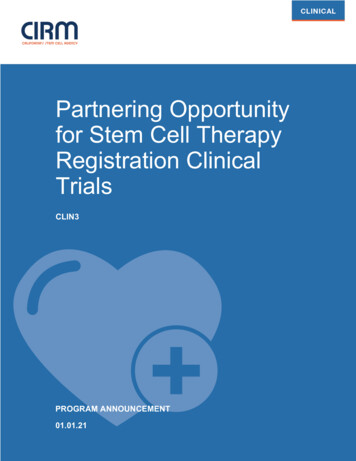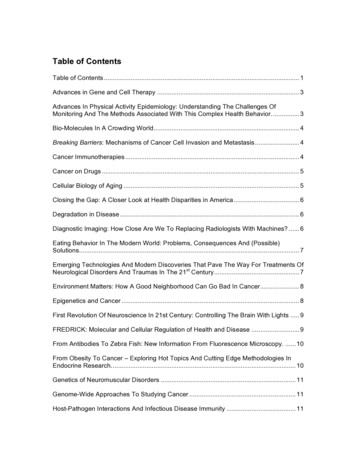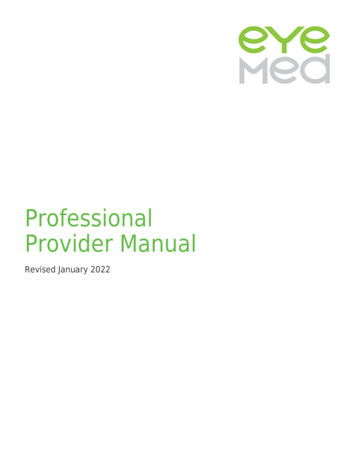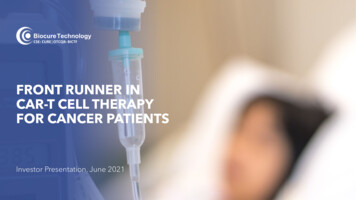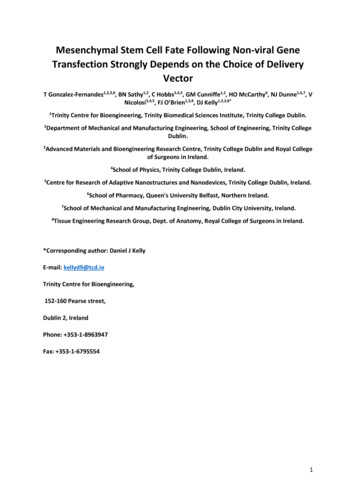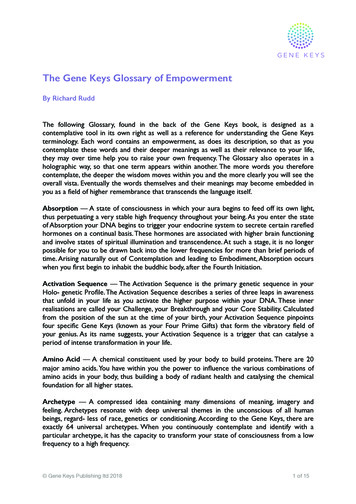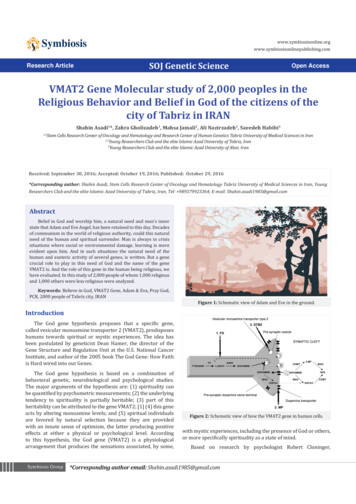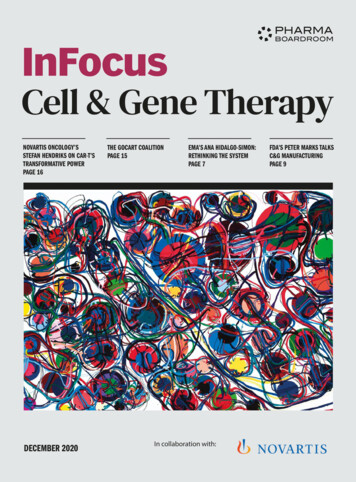
Transcription
InFocusCell & Gene TherapyNOVARTIS ONCOLOGY’SSTEFAN HENDRIKS ON CAR-T’STRANSFORMATIVE POWERPAGE 16DECEMBER 2020THE GOCART COALITIONPAGE 15EMA’S ANA HIDALGO-SIMON:RETHINKING THE SYSTEMPAGE 7In collaboration with:FDA’S PETER MARKS TALKSC&G MANUFACTURINGPAGE 9
INFOCUSCELL & GENE THERAPYContentspage 3DECEMBER 2020page 10PREFACEEUROPEINTERVIEWpage 4Niklas Hedberg, EUnetHTAUS FDA APPROVED CELL &GENE THERAPY PRODUCTSpage 12INDUSTRYLEADERINTERVIEWpage 5JAPAN PMDA APPROVEDREGENERATIVE MEDICINEPRODUCTSStefanHendriks,Cell & Gene,NovartisOncologypage 6EMA APPROVED ADVANCEDTHERAPY MEDICINALPRODUCTSOPINIONFEATUREUS Innovative PaymentModelspage 26JAPANINTERVIEWpage 15THE GOCART COALITIONINTERVIEWKen-ichiro Hata, FIRMNicolaus Kröger, EBMTpage 28REGULATORYINTERVIEWpage 17HOSPITALSFEATUREpage 9Thomas D. Szucs, European Centerof Pharmaceutical Medicine at theUniversity of Basel; HirslandenPrivate Hospital, Switzerland;Chairman, Helsana GroupREGULATORYFEATUREpage 19page 7Ana HidalgoSimon, EMAPeter Marks,CBER, US FDAHOSPITALSINTERVIEWCEEFEATUREJon Amund Kyte,Department of ExperimentalCancer Treatment, OUHComprehensive Cancer Center,Oslo University Hospital,Norwaypage 29AFFORDABLE CAR-TFEATURECzech Republic, RomaniaMiguel Forte, BoneTherapeuticsThe special report was producedby PharmaBoardroom.For exclusive interviews and more info, please log onto:www.pharmaboardroom.com or write to contact@focusreports.net.for errors and omissions. Opinions expressed in this report are not necessarily those ofthe authors.Editor: Patrick BurtonGraphic Design: Miriam LeónCopyright: All rights reserved. No part of this publication maybe reproduced in any formor by any means, whether electronic, mechanical or otherwise including photocopying,recording or any information storage or retrieval system without prior written consent ofPharmaBoardroom. While every attempt is made to ensure the accuracy of the informationcontained in this report, neither PharmaBoardroom nor the authors accept any liabilitiesPhoto cover: Tanaka Atsuko ‘93C’. Sotheby’s Photo page 2: Yoshihara Jiro Photo page 10, 11: Photo page 12-13: Illustration by Miriam León Photo page 15-16: Photo page 17, 18: Freepik.com. User: Vectorarte Photo page19: Vecteezy.com. User: commercialart Photo page 22, 24, 25: Illustrations byMiriam LeónIn collaboration with Novartis.2page 22InFocus Cell & Gene Therapywww.pharmaboardroom.com
PrefaceAs innovative pharma continues toinvest heavily in high-risk frontierresearch involving stem cells andthe harnessing of a patient’s ownimmune system to attack the onsetof a disease, a brave new world ofpotentially curative treatment possibilities isunfolding. This has become most evident in fieldslike oncology where expensive, yet thoroughlytransformative CAR-T therapies are displacingclassic treatments and offering newfound hopeto patients where previously there was none.Yet, although cell and gene therapy has alreadybecome a powerful new engine of value creationfor patients and heralds a paradigm shift in thetreatment of some of the world’s most devastating and intractable illnesses, widespread uptakeof these game changing technologies remains,thus far, elusive. Through the comments of topregulators, HTA bodies, and leading industryexecutives, this e-book strives to look in detail atsome of the outstanding bottlenecks and challenges to adoption, while considering potentialsolutions.www.pharmaboardroom.comInFocus Cell and Gene Therapy 3
PRODUCT APPROVALSUS FDAUS FDA APPROVEDCELL & GENE THERAPYPRODUCTSALLOCORD (HPC, CORD BLOOD)SSM Cardinal Glennon Children's MedicalCenterCLEVECORD (HPC CORD BLOOD)Cleveland Cord Blood CenterDUCORD, HPC CORD BLOODDuke University School of MedicineGINTUIT (ALLOGENEIC CULTUREDKERATINOCYTES AND FIBROBLASTS INBOVINE COLLAGEN)Organogenesis IncorporatedIMLYGIC (TALIMOGENE LAHERPAREPVEC)BioVex, Inc., a subsidiary of Amgen Inc.KYMRIAH (TISAGENLECLEUCEL)Novartis Pharmaceuticals CorporationLAVIV (AZFICEL-T)Fibrocall TechnologiesLUXTURNASpark Therapeutics, Inc.MACI (AUTOLOGOUS CULTURED CHONDROCYTESON A PORCINE COLLAGEN MEMBRANE)Vericel Corp.HEMACORD (HPC, CORD BLOOD)New York Blood CenterHPC, CORD BLOODClinimmune Labs, University of Colorado CordBlood BankHPC, CORD BLOOD - MD ANDERSON CORDBLOOD BANKMD Anderson Cord Blood BankHPC, CORD BLOOD - LIFESOUTHLifeSouth Community Blood Centers, Inc.HPC, CORD BLOOD - BLOODWORKSBloodworks4InFocus Cell & Gene TherapyPROVENGE (SIPULEUCEL-T)Dendreon Corp.TECARTUS (BREXUCABTAGENE AUTOLEUCEL)Kite Pharma, Inc.YESCARTA (AXICABTAGENE CILOLEUCEL)Kite Pharma, IncorporatedZOLGENSMA (ONASEMNOGENEABEPARVOVEC-XIOI)AveXis, Inc.Source: FDAwww.pharmaboardroom.com
PRODUCT APPROVALSPMDA (JAPAN)JAPAN PMDA APPROVEDREGENERATIVEMEDICINE PRODUCTSBRAND NAMEGENERIC NAMEAPPROVEDCollategenebeperminogene perplasmidMarch 2019HeartSheethuman (autologous) skeletal myoblast-derived cellsheetSeptember 2015JACChuman autologous tissue for transplantationJuly 2012human (autologous) epidermal cell sheetOctober 2007human (autologous) epidermal cell sheetSeptember 2016human (autologous) epidermal cell sheetDecember 2018KymriahtisagenlecleucelMarch 2019Nepichuman (autologous) corneal limbus-derived cornealepithelial cell sheetMarch 2020Stemirachuman (autologous) bone marrow-derived mesenchymal stem cellsDecember 2018Temcellhuman (allogeneic) bone marrow-derived mesenchymalSeptember 2015stem cellsZolgensmaonasemnogene abeparvovecJACE*Initial ApprovalJACEPartial Change ApprovalJACEPartial Change ApprovalMarch 2020* This product was approved as a medical device under the previous regulatory framework.www.pharmaboardroom.comInFocus Cell & Gene Therapy 5
PRODUCT APPROVALSEMA (EUROPE)EMA APPROVEDADVANCED THERAPYMEDICINAL PRODUCTSNAMEDEVELOPERINDICATIONAPPROVAL DATESTATUSZyntegloBluebird bioBeta-thalassemiaJune 2019ConditionalapprovalLuxturnaSpark TherapeuticsRetinal dystrophySeptember 2018ApprovedYescartaKite PharmaBlood cancerAugust 2018ApprovedKymriahNovartisBlood cancerAugust 2018ApprovedAlofiselTiGenixPerianal fistulas in Crohn’sdiseaseMarch 2018ApprovedSpheroxCO.DONCartilage defects in the kneeMay 2017ApprovedZalmoxisMolMedStem cell transplantation inhigh-risk blood cancerJune 2016ApprovedStrimvelisGSKADA-SCIDApril 2016ApprovedImlygicAmgenMelanomaOctober 2015ApprovedHoloclarChiesiSevere limbal stem celldeficiency in the eyesMarch 2015ApprovedProvengeDendreonMetastatics prostate cancerOctober 2013Withdrawn in2015MACIVericelCartilage defects in the kneeJuly 2013Withdrawn in2014GlyberauniQureLipoprotein lipase deficiency(LPLD)November 2012Withdrawn in2017ChondrocelectTiGenixCartilage defectsNovember 2009Withdrawn in2016Source: Labiotech.eu6InFocus Cell & Gene Therapywww.pharmaboardroom.com
REGULATORYAna Hidalgo-Simon, EMAEMA:RETHINKINGTHE SYSTEMEMA’s Head of Advanced Therapies Dr Ana Hidalgo-Simon outlines Europe’s evolving regulatoryframework for regenerative medicines and touches on ethical and pricing challengesIn the US, the work on regenerative medicines hasreally been driven by the 21st Century Cures Act,which outlined a clear direction for the US FDA.What are for Europe the guiding principles of yourwork at the Office for Advanced Therapies?ANA HIDALGO-SIMON (AHS): As you alluded to,the systems in the US and Europe are completely different, to the point that even the definitions for thesetherapies are different: regenerative therapies versusadvanced therapies. Our legislations are also different.The basic principle is that we want these medicinesto be used by the patients, not merely available in themarket. That is quite a departure from the traditional approach where regulators would not worry aboutthe commercial viability of a product. However, foradvanced therapies, market approval is not the end ofthe journey, and we really want to reach the final destination, which is having patients benefit from thesetherapies. Access is fundamental.The other aspect of advanced therapies is that werealized that we need to engage and work with academics a lot more because many of the ideas and initial research actually come from that community, whohave not traditionally been commercial drug developers.Therefore, they are less familiar with the regulatory andclinical development processes, the post-authorizationrequirements, large-scale clinical trials, etc. At the sametime, because patients are more involved in the development, there is a seminal role for them to play as well.Even before the formation of the Office for AdvancedTherapies, EMA’s Committee for Advanced Therapies(CAT) included patient and healthcare professional representatives as full members, with full voting rights.www.pharmaboardroom.comDr Ana Hidalgo-Simonhead of Advanced Therapies, EMAAt EMA, among other incentives and support tools for developers, we have the PRIMEscheme, which is intended to enhance the support for the development of medicines thattarget an unmet medical need, including butnot limited to advanced therapies. However,due to the revolutionary nature of advancedtherapies, we have noticed that around half ofall PRIME products are now advanced therapies, and this is because the scheme worksvery well for these advanced therapies, facilitating early dialogue and scientific advice, withnumerous benefits for sponsors. For instance,we appoint a rapporteur from the Committeeon Advanced Therapies to provide continuoussupport, and we also provide scientific adviceat key development milestones.What are some of the main ethical challenges your office has faced in regulatingadvanced therapies?AHS: One of the main issues is how to dealwith out-of-specification therapies, i.e., whenan advanced therapy presents one or moreparameters that fall outside the authorizedspecifications. This is not an uncommonoccurrence. The ethical dilemma is that youhave a product that falls outside establishedparameters, but has been produced using theInFocus Cell & Gene Therapy 7
REGULATORYAna Hidalgo-Simon, EMApatient’s own material, and sometimes thepatient’s condition is so severe that they arerunning out of time. The argument is whether the product should be used on the patientanyway? This is a very difficult choice, and itrequires a dialogue between the patient andtheir doctor, certainly. From our side, we arealways trying to avoid this scenario, and wework with sponsors closely to ensure that wedefine the best product specifications. Wecannot have specifications so tight that products fall out of them frequently and materialsare wasted but we also need to ensure that wehave efficacious and safe therapies. At the endof the day, we need to set some parameters –and to do that well, we have to work very, veryclosely with all the stakeholders.With how new this field is and how quickly it is advancing, how does EMA stay ontop of all the new developments?AHS: Firstly, we draw upon all the nationalexperts that are exploring these areas. Theirsystems and processes are not uniform, butthey are working with their own nationalexperts and academics, and our committeesdraw representatives from each country tobring all of their expertise together. The workof EMA is very much of coordination, alignment and compensation, and through that,we have insights into the upcoming and ongoing innovations.For instance, we know that gene therapy is rapidly dominating this space, and wehave access to a lot of scientific and academicadvice and research. We also see that manynew innovations, for instance, like drug-device combinations and health wearables andso on, no longer fall into clear-cut categoriesof drug, device or other. The field is evolving,and the boundaries are blurring, so we arealso preparing for this, partly through therecruitment of experts – though not so muchnow due to the COVID-19 situation – andpartly through our dialogues and exchangeswith national regulators, who are themselvesexploring these areas.8InFocus Cell & Gene TherapyThere are many players in these new areas, from Big Pharmacompanies to small- and medium-sized enterprises, many ofwhom are spin-offs from academic and research institutions, soin that context, working with academics and other experts alsohelps us avoid duplicating research or reinventing the wheel.Through all these efforts, we have become much better at outlining and anticipating the regulatory science for these new areas.We also have our regulatory strategy to 2025, at EMA level andsoon at EU level, overarching all national agencies.You highlighted that access is fundamental for the Officewhen it comes to advanced therapies- to avoid approvingtherapies that then never reach patients. Since in Europe itcomes down to the national health systems and payers whenit comes to pricing and reimbursement, is there any meansof coordination regarding access to approved therapies?AHS: Access and affordability are fundamental worries forpatients. The new Executive Director of EMA, Emer Cooke, hasmade it clear in her initial weeks that these are our main concerns. Traditionally, indeed, pricing and reimbursement are notresponsibilities of EMA because these are set by national authorities. But we have started to have conversations with various stakeholders, including HTAs and payers at the EU level. Actually,this work began a few years ago. The idea is that the systems inthese countries are already quite scattered, but we can help in certain ways. For instance, we spoke to the European Network forHealth Technology Assessment (EUnetHTA) about the kind ofinformation they need to maketheir decisions, so we could discuss how we could align ourrequirements. This would helpdrug developers and sponsorscollect and arrange their datain an efficient way that wouldstill meet all of our needs at thesame time. We cannot just thinkabout ourselves in isolation, weare pieces of a larger puzzle.We need to rethink the systemto ensure not only that a medicine is approved but also that itstays on the market. There havebeen cases of advanced therapies, approved ten years ago, that were no longer available becausethe manufacturer considered them no longer commercially viable. We have to work harder to ensure that these therapies ultimately reach the patients.We need torethink thesystem toensure not onlythat a medicineis approved butalso that it stayson the market.www.pharmaboardroom.com
REGULATORYPeter Marks, CBER, US FDATHE BUILDING BLOCKS OFGENE THERAPYDr Peter Marks, director of the US FDA’s Center forBiologics Evaluation and Research (CBER) examines the successes of the Regenerative MedicineAdvanced Therapy (RMAT) designation since itsintroduction in 2016 and outlines the importanceof a regulatory & scientific infrastructure for genetherapy manufacturing.approval but we might want to see how the bladders wouldcontinue to function after a year or two, so we would be ableto simply ask the sponsor to return in six months or anotheryear with more data on that same group of patients.Dr PeterMarksWe have received a large number of applications, especiallyin the area of cell-based regenerative medicine, but manywere requested early on in the development process. It takestime for these products to work their way through, and it is ayoung field as well, which tends to have more products thatdo not make it through the entire product development process. We know the statistics of product development: onlyabout 10 percent of the therapies that make it into Phase1 trials will ever see the light of day. Cell therapies are notall that different at this point. I am sure we will see some inthe near future, but it is taking a little longer than might havebeen thought.director, Centerfor BiologicsEvaluation andResearch (CBER),US FDAOn what the RMAT Designation is The RMAT designation is very much like the BreakthroughTherapy designation but with certain features targeted forregenerative medicine products. The first is that, as opposedto the criterion for Breakthrough Therapy designation thatrequires the product be better than an existing standard ofcare, for the RMAT designation, the company simply has toshow evidence of activity against the disease in question,instead of showing that the therapy is better than a standard of care. The second is that, should a therapy with RMATdesignation be approved under an accelerated approval pathway, which would then require a confirmatory trial, there is anextended array of ways of fulfilling that post-approval commitment. Under standard rules, one cannot simply follow thesame patients in the registrational trial for a longer period oftime. But for RMAT designated therapies, that is an option.To illustrate, imagine a hypothetical therapy in whichreplacement bladders are made by seeding cells on scaffolds. If the therapy receives RMAT designation and a clinicaltrial is performed, after six months of appropriate replacement bladder functioning, we could grant it acceleratedwww.pharmaboardroom.comOn reduced approval numbers comparedto exorbitant amount of applications.On developing a regulatory & scientificinfrastructure for gene therapymanufacturing We are very interested in helping to move the field forwardby looking at how one can develop gene therapies for smallpatient populations and also how to do that in what would ultimately be a commercially viable manner. Right now, gene therapy populations that include fewer than 100 patients treatedper year are important targets for development. However, dueto the expenditures involved in R&D, approval and commercialization, these therapies are not seen as commercially viable targets for companies. On the other hand, if regulatoryframeworks and science could be developed for the manufacture of gene therapies, such as reusing certain vectorsand changing out inserts, or the use of common manufacturing protocols and techniques, manufacturing costs could bereduced sufficiently to interest more companies into workingon gene therapies for patient populations of 50 or 100 people. That could make a big difference in people’s lives.InFocus Cell & Gene Therapy 9
EUROPENiklas Hedberg, EUnetHTAEUnetHTA:SEPARATING THECHALLENGESNiklas Hedberg outlines how EUnetHTA has adapted to cell andgene therapies, squaring the affordability circle, and why discussions about value assessment, cost effectiveness, payment, andfinancing models are all separate discussions to be resolved.When confronted with paradigm-shifting cell and gene therapies, what questions has EUnetHTA had to ask itself and itspeers?NIKLAS HEDBERG (NH): Wehave had to relate to new kinds ofevidence which are structured innew ways. For example, there hasbeen a need to handle umbrella, basket, and single-arm trialsas grounds for medical approval;meaning that the clinical trial paradigm has been turned upside down.Over the past five to ten years,we are, on national and regionallevel, increasingly being asked togrant reimbursement for productswhere the data is based on Phase Istudies, even though, traditionallythese studies only included healthyvolunteers. This is especially true of10InFocus Cell & Gene TherapyNiklas Hedbergchair of the Executive Board,EUnetHTAnew products in oncology, orphandrugs and precision medicine.This is of course challenging butwe must not forget the basic toolswith which we start every assessment. In the national setting atTLV we had our first experienceswith CAR-T about two years ago.Then we realised that many of thechallenges we were facing were alsothose facing us in assessing traditional products. The difference isthat these uncertainties were multiplied by a larger number for celland gene therapies.After that, since medical approval had already been granted, we hadto focus on follow-up data and evidence generation and how we wereable to make wise decisions nowthat are still meaningful for thedownstream decision maker. Wemust maintain the triangle of relevance, predictability, and flexibility.If the HTA always says that moreresearch is needed and that the datais too weak to draw any conclusions, then downstream stakeholders like regions, individual clinics,and clinicians will have to meet thepatient and make decisions withoutus. Therefore, TLV has preferred tosay that an assessment result is veryuncertain and that it is of utmostimportance to follow-up and generate further data. Clinicians shouldknow that they have a responsibility, if they want to use an expensivenew drug, to make sure that we canfollow up the results.How do you foresee the evolution of these therapies impactingyour work and how are you planning to square the affordabilitycircle?NH: I need to look into the pipeline more and update my horizonscanning a bit, but we will probablybe having this same discussion forthe upcoming three to five years.There will be an ever-increasingnumber of products and an increaswww.pharmaboardroom.com
EUROPENiklas Hedberg, EUnetHTAing number of patients, but ultimately, they will still serveonly fairly small patient groups.In the longer run of the next eight to ten years thereneeds to be a shift, as even the wealthier nations are challenged on affordability. I cannot see how, in general, we willbe able to afford all these interventions with the prices thatthey come with today.That is a tremendously difficult discussion. Right now,we can still afford the discussion that perhaps we haven’tput all the value components into the equation. Perhaps weneed to rethink how we do the analysis. But in the long run,for equitable care, more and more people are starting totalk about national responsibility for these therapies rather than the responsibility lying with individual hospitals.I am not going to judge whether that is a positive or negative development, but the national money also needs tocome from somewhere. National budgets will also havetheir limits. I am seriously worried about the affordability of precision medicines if we don’t start talking abouta shift to something more sustainable for developers,patients, assessors, and payersWhat would you like developers, regulators, and otherstakeholders to keep in mind about cell and gene therapies moving forward?NH: We are trying to formulate that there are differentand separate challenges. The first challenge is a just assessment of the value of a product. There are a number of difficulties there, including the assessment of new kinds ofevidence or putting a value on a product that may be givenin combination with another.Then there needs to be a discussion and an agreementon how to evaluate cost effectiveness. Although not allcountries work with cost effectiveness, there are questionsaround how calculations and analysis is done and what canbe brought in from the value and costing discussions.The third challenge is different payment models, whether they are made based on assumptions or results and howthey are discussed.Finally, there also needs to be a discussion about financing models; how is the money going to be paid, when, forwhat kinds of results, and where is it going to come from?It is useful not to mix these discussions, but to realiseand clearly state that these are different kinds of discussions. We must try to solve them all. Just going in veryfiercely to the discussion about value and cost effectivenessdoes not solve the financing issue.www.pharmaboardroom.comThe Future ofEUnetHTA“Three years ago, the EC produced thefirst proposal on the future model forHTA. After the political decision-makingthat is still ongoing in the Council of theEuropean Union after a number of differentpresidencies, it seems that during the endof the German presidency (July-December2020) and the beginning of the Portuguesepresidency (January-June 2021), anagreement will be struck and a decisionmade about which HTA regulation Europewill adopt in the future.“That means that the project base andthe joint action base might eventuallycome to an end. But hopefully the networkwill remain, where we have a pool ofparticipating agencies, communicationand information exchange, interaction, andmutual learning.“It is not possible to entirely say [if therebe a mandated law about HTA assessmentacross Europe] because discussions amongmember states in the Ministerial Councilare still ongoing, but it will not be a fixedentity like the European Medicines Agency(EMA); it will not be a new EU agency. Itwill probably be a Secretariat, under theCommission, but we will have to wait andsee. However, we can say thatthere will be moreexplicit regulation onhow the networkpartners fromdifferent MemberStates act andwork.”InFocus Cell & Gene Therapy 11
INDUSTRY LEADERStefan Hendriks, Cell & Gene, Novartis OncologyTRULYTRANSFORMATIVEStefan Hendriks, Global Head of Novartis Oncology’s Cell & Gene division outlines the company’s progression to becoming the globalleader in cell and gene therapies, the strategy he has outlined for thebusiness, and the key issues of manufacturing and access.Novartis Oncology is the globalleader in cell and gene therapies.What do you see as the majormilestones of Novartis Oncology’s journey within this space?STEFAN HENDRIKS (SH): Celland gene therapies are truly transformative. With CAR-T therapies,we are entrusted to work with apatient’s own living T-cells. Thatis a huge responsibility as we haveto know where the cells came fromand monitor them carefully everystep of the way. Within the pharma industry, companies always tryto be patient-oriented but with celland gene therapies, that has to bea part of our DNA because we areworking with the patient’s ownliving cells! That sense of purposefulness and responsibility is trulyamazing and inspiring, and it doesnot end with the extraction andmanufacturing process, it also carries forward to the distribution, tothe services we provide, and to ourpartnerships with hospitals, all ofwhich are essential if patients areto benefit from these transformative therapies.There have been many definingmoments for us. We have seen so12InFocus Cell & Gene Therapymany firsts: our therapy was thefirst CAR-T to reach the market, itwas the first CAR-T to be approvedfor two indications, and it was thefirst CAR-T to reach global markets, with initial approvals afterthe US and Europe in Canada,Australia, Japan and a couple ofother Asian markets – and morecoming. Today, this therapy isreimbursed in 27 markets globallyand we have onboarded, qualifiedand trained over 285 hospitals inthe world. I am very proud of that.Being the first mover in thesemarkets, our teams had to partner with local healthcare systemsand payers to explain the valueof CAR-T and to find innovativeways to create access for patients.Healthcare systems are not builtfor one-time, potentially curative,treatments so there was a periodof acclimatization. Value is alsodefined differently in each market so it was essential to listen andunderstand our partners in orderto create a common understanding of the value that CAR-T therapies can deliver, and then to develop and offer innovative models tosupport access.Stefan HendriksGlobal Head, Cell & Gene, NovartisOncologywww.pharmaboardroom.com
INDUSTRY LEADERStefan Hendriks, Cell & Gene, Novartis OncologyAnother significant achievement is that we have nowbuilt the largest and most comprehensive manufacturing platform for cell and gene therapies in the world. Wecurrently have five – soon to be six – active manufacturing sites across four continents.What strategy have you outlined for the businessmoving forward?SH: From all my previous roles, I have learnt that itis essential to define clear and strategic focus areas forany business, to ensure that cross-functional teams areworking seamlessly together. Once the teams know theirNorth Star, they can be empowered to work towards it.We have identified three strategic pillars for the business. The first is the commercialization of CAR-T therapies, which means ensuring that we bring them to asmany patients as we can, across different areas. We arecurrently running six CAR-T clinical trials and we arelooking to add a couple more indications.The second is ensuring that our manufacturing iscompetitive in terms of process robustness and capacity, which is why, as I mentioned, we have establisheda number of sites, this year in France, Switzerland andJapan, and we expect the sixth to be open in Australia inthe coming months.www.pharmaboardroom.comThe third is creating an exciting pipeline. Even aswe focus on commercialization of approved CAR-Ts,we also need to dedicate resources to build our portfolio. We are working on a next-generation manufacturing platform that has the potential for higher efficiencies, shorter turnaround times and hopefully betteroutcomes. It will also allow us to preserve a differentsubtype of T-cells that we believe will have a positiveimpact on durability of efficacy. Using this platform, weare developing a portfolio of novel CAR-Ts, addressingmultiple antigen targets across different malignancies.We are also constantly scanning the business landscape and speaking with other players to identify interesting areas for partnership, for instance, in solid tumors or in allogeneic CAR-T therapies. We are definitelywilling to invest if we see the right opportunities.We are also looking to partner on the data front. Wehave generated a lot of manufacturing and clinical data,as well as real world evidence (RWE), so we have startedto partner with IT players such as Microsoft on AI, aswell as Carnegie Mellon University (CMU) to developadvanced analytical models. All these efforts are intended to further improve the cell and gene developmentand manufacturing processes so that we can providebetter outcomes for patients.InFocus Cell & Gene Therapy 13
INDUSTRY LEADERStefan Hendriks, Cell & Gene, Novartis OncologyWhen we spoke to the FDA and EMA regulators on cell and gene therapy, both emphasized the importance of manufacturing and close collaboration with industryon this topic. What is your perspective onthis?SH: I agree with them. As I alluded to, sincewe were the first to launch a CAR-T therapy,we were als
HEMACORD (HPC, CORD BLOOD) New York Blood Center HPC, CORD BLOOD Clinimmune Labs, University of Colorado Cord Blood Bank HPC, CORD BLOOD - MD ANDERSON CORD BLOOD BANK MD Anderson Cord Blood Bank HPC, CORD BLOOD - LIFESOUTH LifeSouth Community Blood Centers, Inc. HPC, CORD BLOOD - BLOODWORKS Bloodworks IMLYGIC (TALIMOGENE LAHERPAREPVEC)
